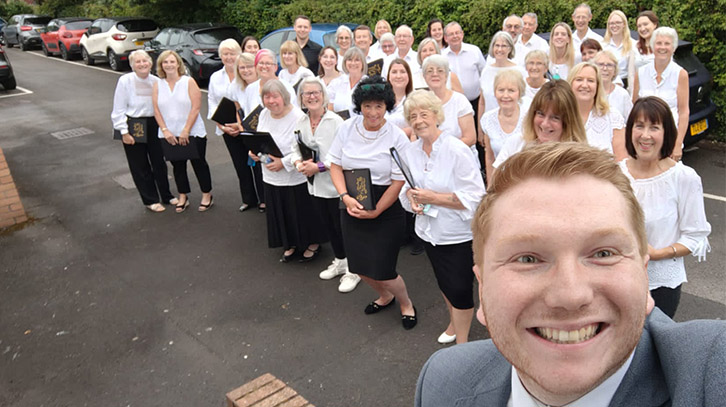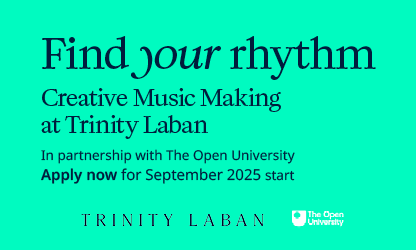Case study: Growing your membership with the Llysfaen Singers
Joanna Burdett, chair of Llysfaen Singers, tells us how, by making small changes over time, the choir have managed to successfully grow their membership.
Background
Llysfaen Singers is a community choir that was formed in 2013, with most of our members coming from the village of Lisvane and neighbouring suburbs, on the northerly edge of Cardiff. Pre-pandemic, the majority of our members were aged 60+, and average membership numbers were about 30-35. Our vision has always been to provide an affordable way to sing an eclectic repertoire and we welcome all, with no audition, whatever their background.
The challenge
At the beginning of the pandemic in March 2020, we could no longer meet in person and did not know how long it would be before we could sing as a choir again. We were determined to carry on and decided to pay our music director and accompanist half fees to retain them. However, membership started to decrease. We knew that we had to act strategically to retain members, tempt at least some to return and recruit more to regain financial stability.
What we did
Marketing and communication
Throughout the pandemic, I attended nearly all Making Music member meetups, and one message rang out loud and clear – look after your existing members because self-esteem, particularly for the older and more vulnerable, could be rock-bottom. Our choir Zoom meetings became a lifeline to some of our members. We also did quizzes, bingo, scavenger hunts and it actually meant that all parts could mix and get to know each other, something hitherto not possible to do. We not only retained most of our existing members, but also developed the choir’s friendly ethos, with new members more likely to stay because they made friends here.
We also wanted to ensure that at least people in Lisvane knew of our existence and would join either now or at some time in the near future. Our starting point was the local magazine, delivered monthly to Lisvane homes. I submitted articles, adverts and photos at least every other month during the pandemic. Luckily for us, there wasn’t much else going on in the village during this time so we often got whole page spreads and excellent exposure. We did manage to recruit a couple of new members while still in the Zoom rehearsal phase. We even had local Senedd member, Julie Morgan, come to see what we had been doing during the pandemic, which meant another double-page spread with photo.
'We not only retained most of our existing members, but also developed the choir’s friendly ethos, with new members more likely to stay because they made friends here.'
After attending the ‘Growing your membership’ Making Music event, I set up a Facebook page to attract more members. In the long term, I envisage it will be used to market our concerts and promote our fundraising efforts. From Facebook’s analytics, we can see that there is now considerable engagement with our posts. We recently recruited our accompanist, an advertising executive, onto the committee as an ex gratia member to help by updating the website, designing more dynamic promotional material, posting regularly in various local Facebook group pages, and writing for the local magazine.
As we were unable to meet in person through the pandemic, communication was very difficult and so the choir newsletter was born. It was a monthly newsletter emailed to all current and recently-lapsed members. When we went back to in-person rehearsals, I also included details on what we were doing to keep everyone safe to build confidence and encourage their return. Newsletters became an important part of the choir and, in conjunction with announcements in rehearsals, are now the main way of communicating with members. Similarly, each section (SATB) has a Voice Rep on the committee and they are in regular contact with their members via email or WhatsApp (the alto group is called Alto-gether!) so that members can ask questions without feeling judged, or even ask if anyone wants to have the excess rhubarb from their allotment!

The Llysfaen Singers posing with MD Tom Lazell before a performance
Data Analysis
Predicting how many members you are going to have in the long, medium or short term is always difficult! But looking at data trends is a useful way of predicting people’s behaviour and can help with planning. During lockdown I kept a register of all members who engaged either wholly or partly with the online rehearsals and social activities. Using this information, data from the Making Music safety survey and taking into account other factors (like their age, family commitments, previous attendance figures etc.), we produced a very accurate picture of those who returned to the choir. I combined all the information by using a red, amber, yellow and green (RAYG) analysis tool. Against each member’s name I put either red for ‘won’t return’, amber ‘probably won’t return’, yellow ‘may return’ and green ‘will return’. Using the RAYG tool helped us to analyse different scenarios, i.e. how many weeks we could afford to meet up per term and the length of each rehearsal whilst paying for fixed costs and keeping our fees the same.
Consultation
In the true spirit of a community choir, we regularly consult with our members. In April 2021 we asked them to complete the Making Music online safety survey indicating what post-lockdown mitigations they expected from us. With this data, I devised a Risk Assessment using the Making Music template. With each revised version (seven in total!), we included all additional mitigations requested. Members were sent an abridged version of each revision in the newsletter and the full version was uploaded on our website. A few previous members did try to return, but singing with a mask, even with a mask insert, was a step too far for some. We consulted again a year later to check on what mitigations members expected even when, legally, there were no restrictions in place. Incidentally, not one person came down with Covid as a result of coming to in-person rehearsals!
'Consultation has improved the quality of information we use and has strengthened the relationship between the committee and the choir. Members are always encouraged to give their views and these are really at the heart of everything we do.'
Members are now regularly consulted about other things, like organising events or concerts. The big consultation came last June when members were surveyed about choir improvement, which we used to devise our improvement plan.
Consultation has improved the quality of information we use and has strengthened the relationship between the committee and the choir. Members are always encouraged to give their views and these are really at the heart of everything we do.
Planning for improvement
As a result of attending a Wales meetup, I discovered a couple of grants from Tŷ Cerdd which distributes Lottery funds on behalf of the Arts Council of Wales. These helped cover our losses due to Covid and helped purchase vital PPE. We also applied for further funding from the National Lottery and Admiral Insurance. Being awarded these grants was an absolute godsend because our bank balance is healthy once more. This not only means that we can keep fees low, but has also enabled us to establish part-payment schemes for members who can only attend half a term or have difficulties paying the full price.
Perhaps the most important thing that Covid taught us was that as a committee, we are very competent at working together, and so put together a choir improvement plan. After attending ‘The role of the chair’ Making Music event, I gave out a short three-question survey to our members (incidentally, we have found that paper survey given during rehearsals were more effective than online surveys because you actually got them back at the end of rehearsal!).
'Working with members has definitely enhanced our ethos because everyone’s opinion is respected and everyone is listened to.'
We then formulated four SMART priorities for the coming academic year, including: involving the committee and members in choosing the repertoire; improving the rehearsal format; improving concert techniques; performing to a wider audience; and increasing the number of social events. Each priority had success criteria and was split into two-three manageable targets with timescale, cost and stakeholders. Each target is RAYGed at the end of each term, with red for ‘target not started or negligible progress’, amber ‘some progress’, yellow ‘good progress’ and green is ‘target completed’. Each priority had a short commentary on what has been done so far. On the whole, this has been very positive, we intend to repeat the survey again and check on our members’ views on the improvements.
Working with members has definitely enhanced our ethos because everyone’s opinion is respected and everyone is listened to. It has meant that all members have a shared understanding of the key issues and the reasons for decisions. Communicating progress made, which we do via the newsletter and during rehearsals, has probably been just as important as asking for feedback in the first place because it has given members validity, praise and encouragement. And that is what our choir is all about.
'At the 2022 summer concert, we had 26 members and at the end of spring term 2023, our membership had doubled to 53 – we count that as a massive success!'
What we’ve learned
At the 2022 summer concert, we had 26 members and at the end of spring term 2023, our membership had doubled to 53 – we count that as a massive success!
- Ensure that you communicate effectively because then everyone has all the correct information and you don’t get individuals asking the same questions. Consult on some changes so that members can be empowered and happy with what you’ve put in place, participate enthusiastically and take ‘ownership’ of their choir
- Keep chipping away at your marketing and think outside the box
- Use data analysis to plan where possible because it gives credibility to your actions
- Stick to your vision even if you have to amend what you’re doing along the way
Find out more about the Llysfaen Singers on their website.
We hope you find this Making Music resource useful. If you have any comments or suggestions about the guidance please contact us. Whilst every effort is made to ensure that the content of this guidance is accurate and up to date, Making Music do not warrant, nor accept any liability or responsibility for the completeness or accuracy of the content, or for any loss which may arise from reliance on the information contained in it.



